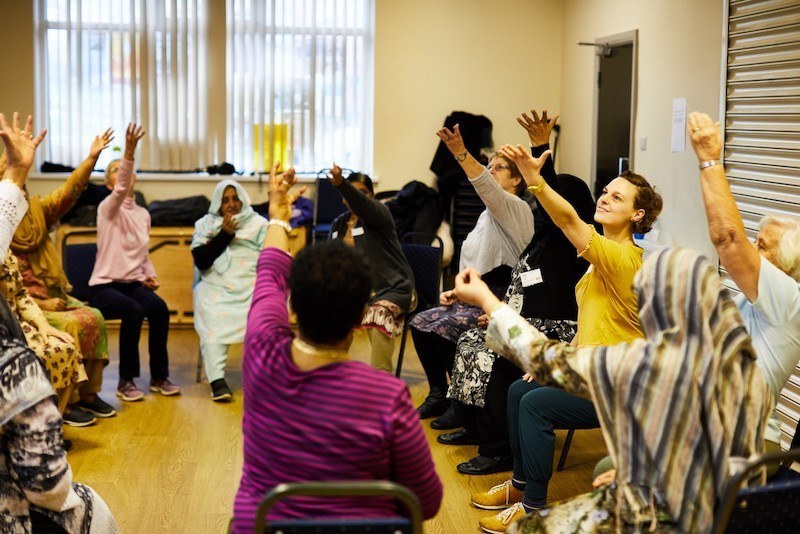Dance to Health (Aesop) – Reducing Falls in Older Adults
Aesop’s Dance to Health programme is a dance solution to the major health challenge of older people’s falls. Falls cost the NHS over £3 billion a year. Well-evidenced physiotherapy programmes reduce falls, but research has revealed ‘dull’ programmes not completed, session leaders not faithful to programme requirements and a lack of ongoing maintenance programmes. With the help of the UK’s strong, well-established community dance movement, Dance to Health solves this by embedding physiotherapy programmes in creative dance sessions, led by specially trained dance artists.
A Sheffield Hallam University evaluation supports the approach with an evidence base: Dance to Health led to:
reduction in falls (58%)
participants more active (96%)
improved mental wellbeing (96%)
making new friends (87%)
The evaluation also identified potential annual savings to the health system of £98m. Following an initial £2.1m funded roll-out, phase two of the roll-out began in 2023. As part of a contract with Innovate UK, Aesop have been further developing local governance models, and creating an online content streaming service for care homes. They are transitioning from being a grand-funded innovation to a model based on earned income from the health sector.
Dr Michael Dixon, NHS England Clinical Lead for Social Prescribing, has observed, “Dance to Health could change our whole approach to giving our elderly population greater resilience.”
Aims and approaches
The aims of Dance to Health are to significantly reduce falls among participants, while allowing them to explore their creativity, and for dance artists to develop their practice in line with their own artistic goals. By working directly in the health system, it is an exemplar of how arts programmes can achieve health outcomes in a well-evidenced, artistically rewarding way.
By embracing the tradition of creative dance, participants and dance artists alike co-create the programme, from top to bottom. Creative dance helps participants find their own pathways to expression, emboldening those who may not have considered dance before, without the confines of traditional dance instruction.
By embedding the falls programmes FaME and Otago, in the form of Postural Stability Instruction (PSI), the sessions simultaneously support participants in the improvement and maintenance of key muscle groups and movement patterns that are proven to help with the reduction in both the quantity and severity of falls.
What makes Dance to Health unique is that it has been proven to work, and that this has been reflected in contracts with the NHS and local authorities across the country.
“Dance to Health’s emphasis on co-production, building the individual and collective agency of older people, is precisely the approach our future health system needs.” −Joint message from NHS Horizons’ Director, Kathryn Perera, and Strategic Advisor, Helen Bevan.
Partnership working
Dance to Health has worked with a range of cross-sectoral partners.
Universities
Sheffield Hallam University conducted a 3-year evaluation of Dance to Health from 2017-2020. This has helped to build a solid evidence base.
Middlesex University to devise a social enterprise model for arts innovations in healthcare, connected with the lessons learned from the programme.
Swansea University in 2023 to come up with a local governance model, such that programmes can become locally managed and self-sustaining.
Councils
Dance to Health has worked with councils including Birmingham, Swansea, Norfolk. An ongoing partnership with Dudley council involves not only the delivery of several weekly in-person sessions. From 2024 this will involve two trials of an online version of Dance to Health for use in care homes.
Cultural sector
Dance to Health works with community dance experts up and down the country. The programme was developed with the help of organisations like South East Dance, Dance East, Birmingham Royal Ballet, Take Art, Yorkshire Dance, Cheshire Dance and National Dance Company Wales
Community Sector
Programmes are often delivered in partnership with community organisations. Recent examples include the Bangladeshi Women’s Association, and Chinese Community Centre, both located in Birmingham. This model helps to reach participants from diverse backgrounds, helping to bridge cultural and language gaps.
Lived Experience
Participants co-create their sessions with each other and their Dance Artists. At the end of every session there is time for socialising, with refreshments. Here, participants can open up with one another, and with their Dance Artist, about how their sessions are shaping them, and how they hope to shape their sessions.
The next steps are to scale across the UK, by further embedding the programme in health service provision.

More Creative Health Review Case Studies >>
Find out more about NCCH's and the All-Party Parliamentary Group on Arts, Health and Wellbeing (APPG AHW) Creative Health Review >>